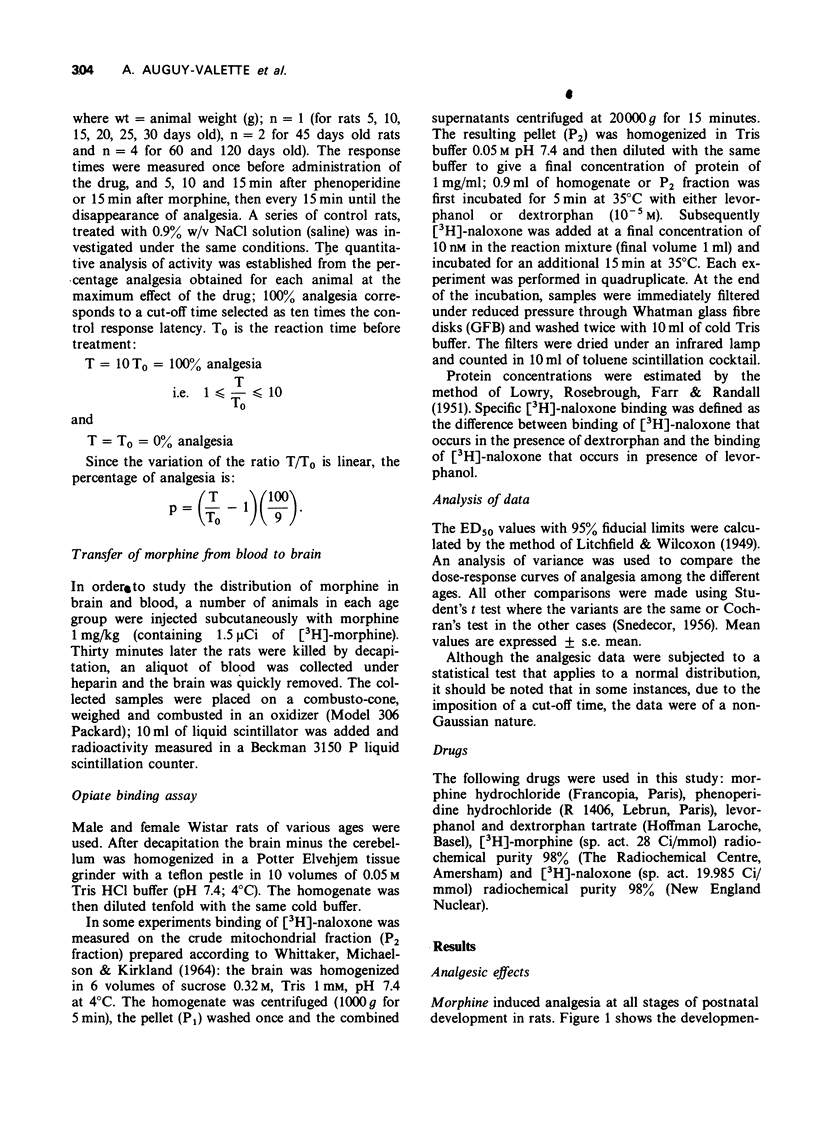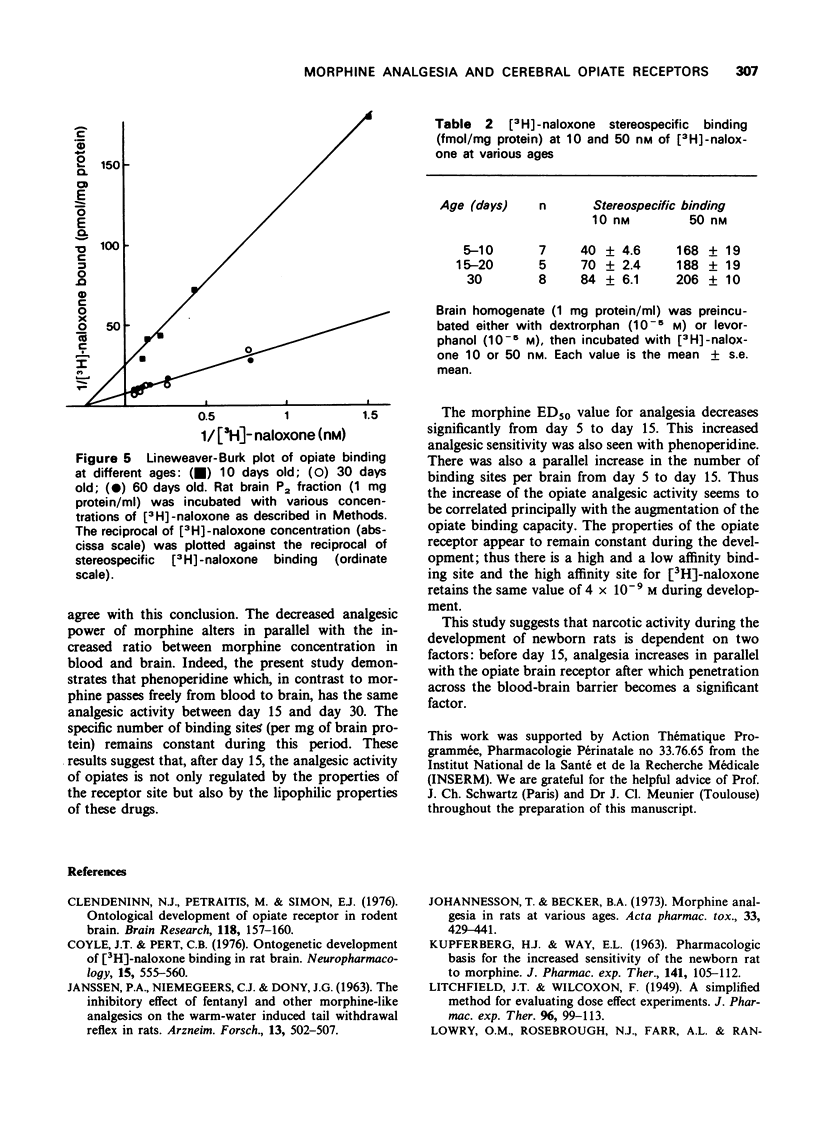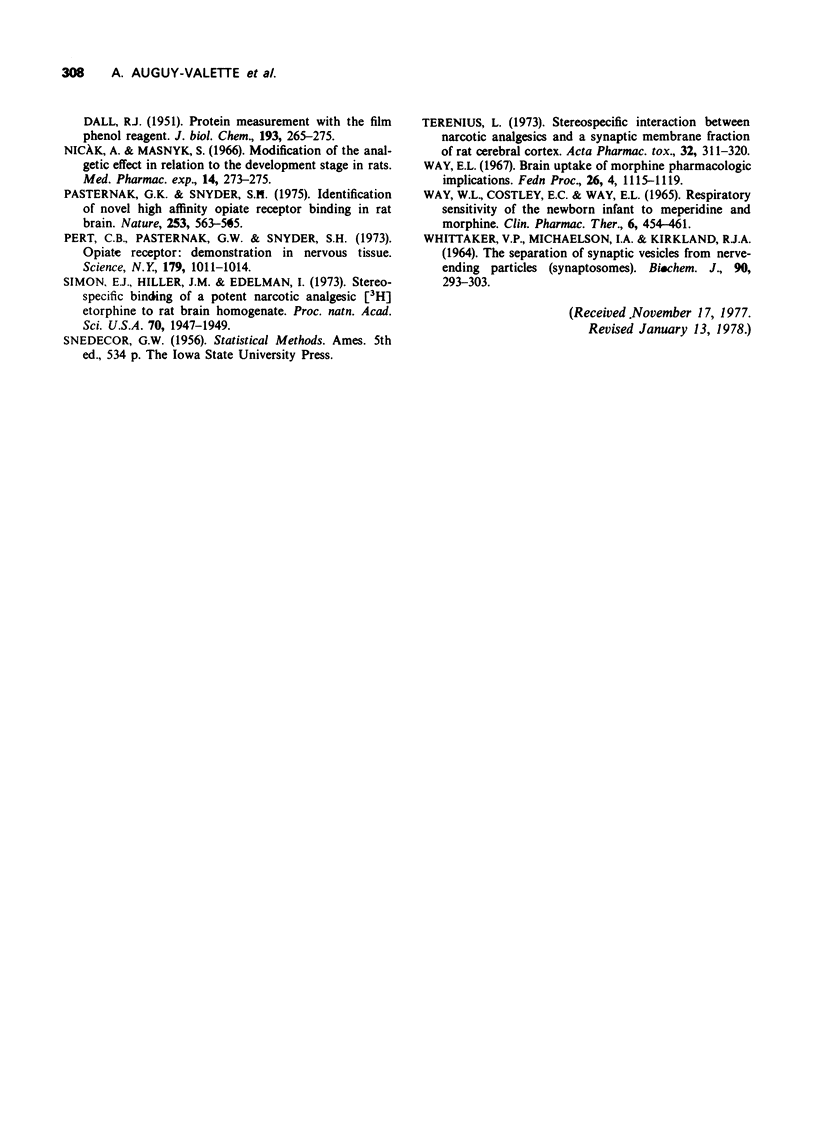Abstract
1 Development of the analgesic response to morphine and ontogenesis of central opiate receptors were analyzed in rats 5 to 120 days old. 2 The analgesic effect of morphine increased until day 15, after which it decreased to reach a plateau at about day 30. With phenoperidine, on the other hand, the analgesic effect increased until day 15, remained constant between day 15 and day 30 after which it decreased slowly. 3 The ratio of the amounts of morphine in blood over those in brain increased about 3 fold between day 15 and day 30. 4 Opiate receptors were detected in the brain of newborn rats: stereospecific binding of [3H]-naloxone at 10 and 50 nM indicated the presence of low and high affinity binding sites. 5 The number of [3H]-naloxone binding sites increased rapidly during the second and third week after birth. Their affinity for several opiates remained constant throughout development. 6 These results indicate that the analgesic activity of opiates varies with age: until day 15, the analgesic effect of opiates increases in parallel with the number of opiate brain receptors. Then, the formation of the blood brain barrier introduces an additional step in the regulation of opiate activity.
Full text
PDF





Selected References
These references are in PubMed. This may not be the complete list of references from this article.
- Clendeninn N. J., Petraitis M., Simon E. J. Ontological development of opiate receptors in rodent brain. Brain Res. 1976 Dec 10;118(1):157–160. doi: 10.1016/0006-8993(76)90852-0. [DOI] [PubMed] [Google Scholar]
- Coyle J. T., Pert C. B. Ontogenetic development of [3H]naloxone binding in rat brain. Neuropharmacology. 1976 Sep;15(9):555–560. doi: 10.1016/0028-3908(76)90107-6. [DOI] [PubMed] [Google Scholar]
- Jóhannesson T., Becker B. A. Morphine analgesia in rats at various ages. Acta Pharmacol Toxicol (Copenh) 1973;33(5):429–441. doi: 10.1111/j.1600-0773.1973.tb01544.x. [DOI] [PubMed] [Google Scholar]
- KUPFERBERG H. J., WAY E. L. Pharmacologic basis for the increased sensitivity of the newborn rat to morphine. J Pharmacol Exp Ther. 1963 Jul;141:105–112. [PubMed] [Google Scholar]
- Nicák A., Masnyk S. Modification of the analgetic effect in relation to the development stage in rats. Med Pharmacol Exp Int J Exp Med. 1966;14(3):273–275. doi: 10.1159/000135794. [DOI] [PubMed] [Google Scholar]
- Pasternak G. W., Snyder S. H. Identification of novel high affinity opiate receptor binding in rat brain. Nature. 1975 Feb 13;253(5492):563–565. doi: 10.1038/253563a0. [DOI] [PubMed] [Google Scholar]
- Pert C. B., Snyder S. H. Opiate receptor: demonstration in nervous tissue. Science. 1973 Mar 9;179(4077):1011–1014. doi: 10.1126/science.179.4077.1011. [DOI] [PubMed] [Google Scholar]
- Simon E. J., Hiller J. M., Edelman I. Stereospecific binding of the potent narcotic analgesic (3H) Etorphine to rat-brain homogenate. Proc Natl Acad Sci U S A. 1973 Jul;70(7):1947–1949. doi: 10.1073/pnas.70.7.1947. [DOI] [PMC free article] [PubMed] [Google Scholar]
- Terenius L. Stereospecific interaction between narcotic analgesics and a synaptic plasm a membrane fraction of rat cerebral cortex. Acta Pharmacol Toxicol (Copenh) 1973;32(3):317–320. doi: 10.1111/j.1600-0773.1973.tb01477.x. [DOI] [PubMed] [Google Scholar]
- WAY W. L., COSTLEY E. C., LEONGWAY E. RESPIRATORY SENSITIVITY OF THE NEWBORN INFANT TO MEPERIDINE AND MORPHINE. Clin Pharmacol Ther. 1965 Jul-Aug;6:454–461. doi: 10.1002/cpt196564454. [DOI] [PubMed] [Google Scholar]
- Way E. L. Brain uptake of morphine: pharmacologic implications. Fed Proc. 1967 Jul-Aug;26(4):1115–1118. [PubMed] [Google Scholar]
- Whittaker V. P., Michaelson I. A., Kirkland R. J. The separation of synaptic vesicles from nerve-ending particles ('synaptosomes'). Biochem J. 1964 Feb;90(2):293–303. doi: 10.1042/bj0900293. [DOI] [PMC free article] [PubMed] [Google Scholar]


